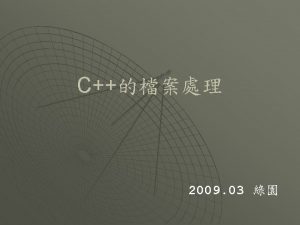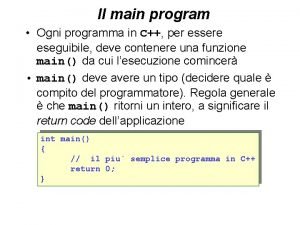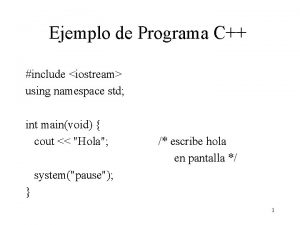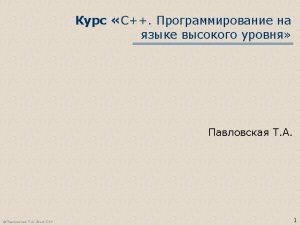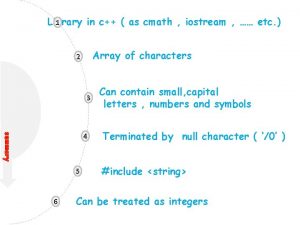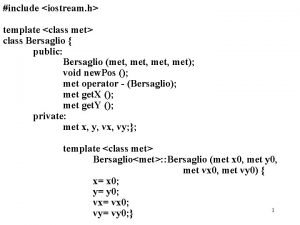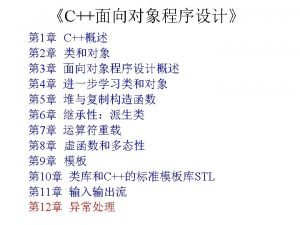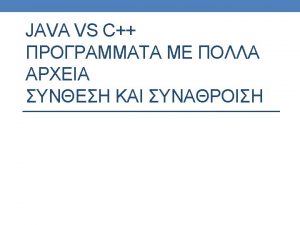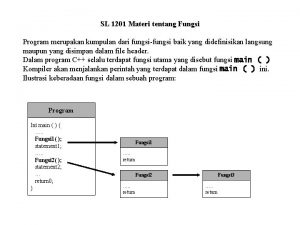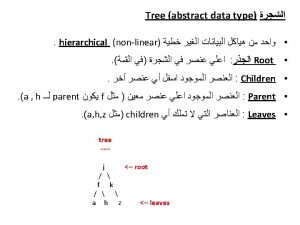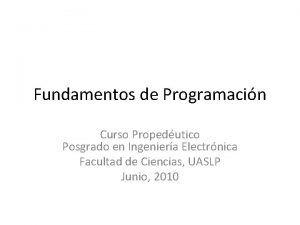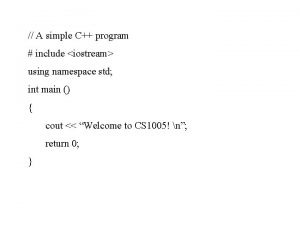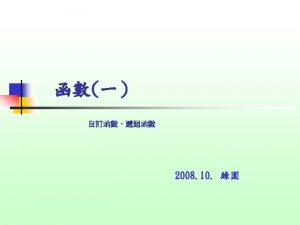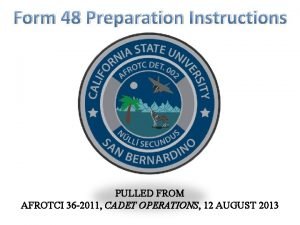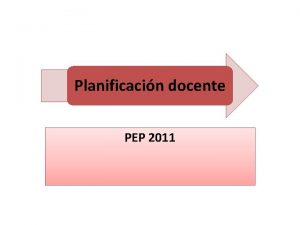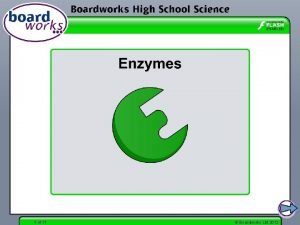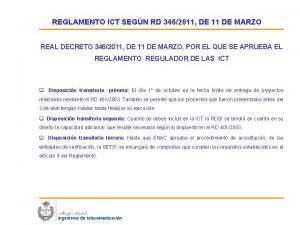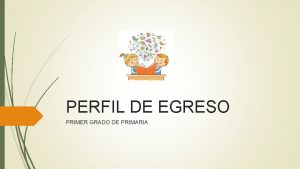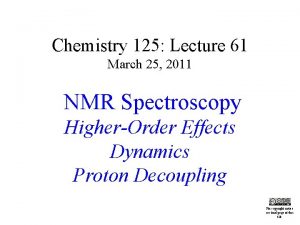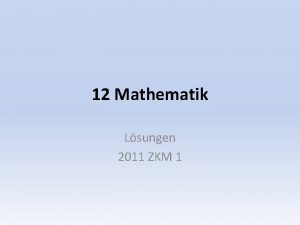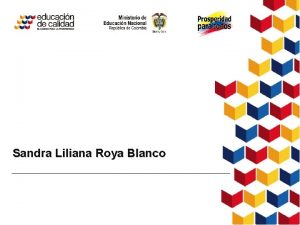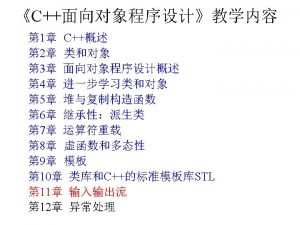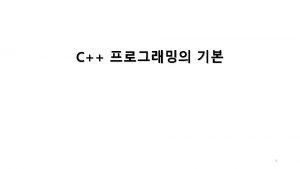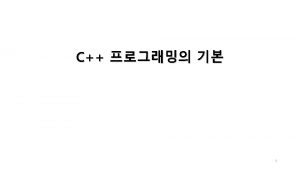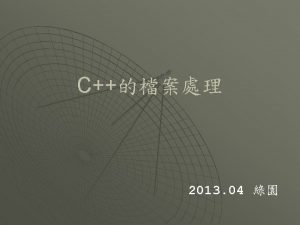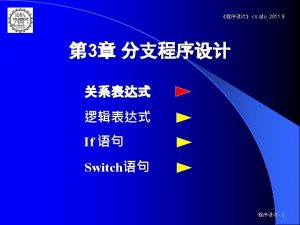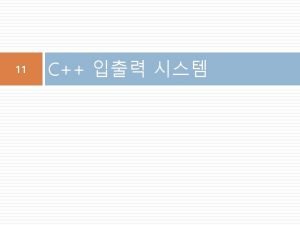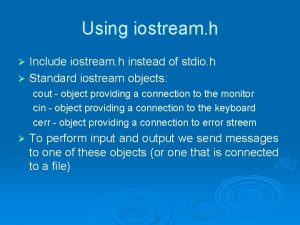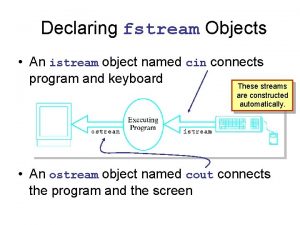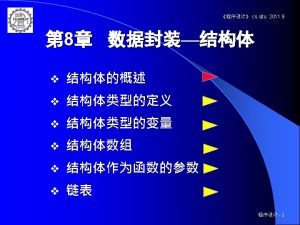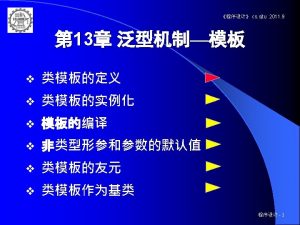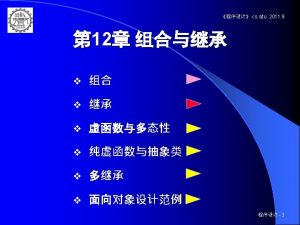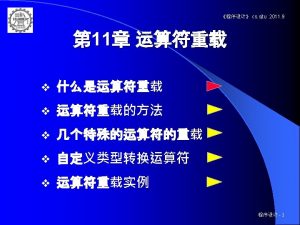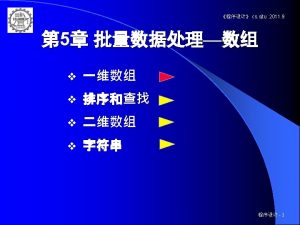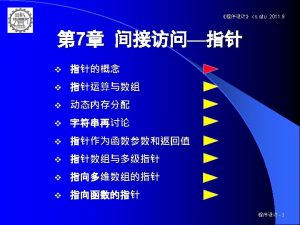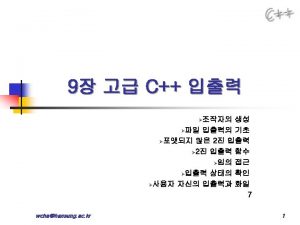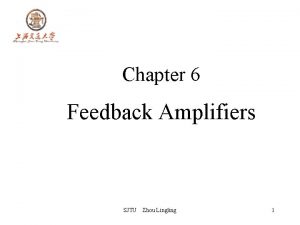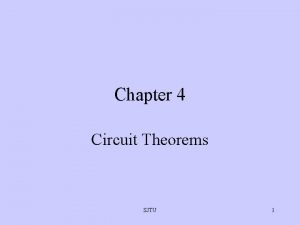cs sjtu 2011 9 iostream istream ostream iostreamistreamostream


























































































![《程序设计》 cs. sjtu 2011. 9 add. Book的实现 void add. Book() { char ch[20]; book 《程序设计》 cs. sjtu 2011. 9 add. Book的实现 void add. Book() { char ch[20]; book](https://slidetodoc.com/presentation_image_h2/80088b7d4eaaa8882b0d71e0c0cd2e4a/image-91.jpg)







- Slides: 98




《程序设计》 cs. sjtu 2011. 9 流与标准库 头文件 类型 iostream istream从流中读取 ostream写到流中去 iostream对流进行读写,从istream和ostream派生 fstream ifstream从文件中读取,由istream派生而来 ofstream写到文件中去,由ostream派生而来 fstream对流进行读写,由iostream派生而来 sstream istringstream从string对象中读取,由istream派生而来 ostringstream写到string对象中去,由ostream派生而来 stringstream对string对象进行读写,由iostream派生而来 程序设计 - 4

《程序设计》 cs. sjtu 2011. 9 类的继承关系 ios istream istringstream ifstream ostream iostream fstream ostringstream 程序设计 - 5









《程序设计》 cs. sjtu 2011. 9 输出流 #include <iostream> using namespace std; int main() {int a = 5, *p = &a; double x = 1234. 56; char ch = 'a'; cout << "a = " << a << endl; cout << "x = " << x << endl; cout << "ch = " << ch << endl; cout << "*p = " << *p << endl; cout << "p = " << p << endl; return 0; } a=5 x = 1234. 56 ch = a *p = 5 p = 0012 FF 7 C 地址用十六进制输出 程序设计 - 14


《程序设计》 cs. sjtu 2011. 9 #include <iostream> using namespace std; int main() {char *ptr = "abcdef"; cout << "ptr指向的内容为: " << ptr << endl; cout << "ptr中保存的地址为:" << (void*)ptr << endl; return 0; } ptr指向的内容为:abcdef ptr中保存的地址为: 0046 C 04 C 程序设计 - 16







《程序设计》 cs. sjtu 2011. 9 #include <iostream> using namespace std; int main() {int grade, highest. Grade = -1; cout << "Enter grade (enter end-of-file to end): "; while ( cin >> grade) { if ( grade > highest. Grade) highest. Grade = grade; cout << "Enter grade (enter end-of-file to end): "; } cout << "nn. Highest grade is: "<< highest. Grade << endl; return 0; } 程序设计 - 23

《程序设计》 cs. sjtu 2011. 9 输出结果: Enter grade (enter end-of-file to end): 67 Enter grade (enter end-of-file to end): 87 Enter grade (enter end of file to end): 73 Enter grade (enter end-of-file to end): 95 Enter grade (enter end-of-file to end): 34 Enter grade (enter end-of-file to end): 99 Entergrade (enter end-of-file to end): ^ z Heighest grade is: 99 程序设计 - 24



《程序设计》 cs. sjtu 2011. 9 #include <iostream> Using namespace std; int main() { char c; while ( ( c = cin. get() ) != EOF ) cout. put( c ); cout << "n. EOF in this system is: "<< c; return 0; } 程序设计 - 27

《程序设计》 cs. sjtu 2011. 9 输出结果: Enter a sentence followed by end-of-file: Testing the get and put member functions^z Testing the get and put member functions EOF in this system is: -1 程序设计 - 28




《程序设计》 cs. sjtu 2011. 9 #include <iostream> Using namespace std; int main() { const int SIZE = 80; char buffer 1[ SIZE ], buffer 2[ SIZE ] ; cout << "Enter a sentence: n"; cin >> buffer 1; cout << "n. The string read with cin was: n" << buffer 1 << "nn"; cin. get( buffer 2, SIZE ); cout << "The string read with cin. get was: n" << buffer 2 << endl; return 0; } 程序设计 - 32

《程序设计》 cs. sjtu 2011. 9 输出结果: Enter a sentence: Contrasting string input with cin and cin. get The string read with cin was: Contrasting The string read with cin. get was: string input with cin and cin. get 程序设计 - 33


《程序设计》 cs. sjtu 2011. 9 #include <iostream> Using namespace std; int main() { const SIZE = 80; char buffe[ SIZE ]; cout << "Enter a sentence: n"; cin. getline( buffer, SIZE ); cout << "n. The sentence entered is: n" << buffer << endl; return 0; } 程序设计 - 35

《程序设计》 cs. sjtu 2011. 9 输出结果: Enter a sentence: Using the getline member function The sentence entered is: Using the getline member function 程序设计 - 36


《程序设计》 cs. sjtu 2011. 9 #include <iostream> using namespace std; int main() {char buffer[ 80 ]; cout << "Enter a sentence: n"; cin. read( buffer, 20 ); cout << "n. The sentence entered was: n"; cout. write( buffer, cin. gcount() ); cout << endl; cout << "一共输入了" << cin. gcount() << "个字符n"; return 0; } 程序设计 - 38

《程序设计》 cs. sjtu 2011. 9 输出结果: Enter a sentence: Using the read, write, and gcount member functions The sentence entered was: Using the read, write 一共输入了 20个字符 程序设计 - 39




《程序设计》 cs. sjtu 2011. 9 hex、oct、dec和setbase #include <iostream> Enter a octal number: 30 #include <iomanip> Octal 30 in hexdecimal is: 18 using namespace std; Hexdecimal 18 in decimal is: 24 int main() Octal 30 in octal is: 30 {int n; cout << "Enter a octal number: "; cin >> oct >> n; cout << "octal " << oct << n << " in hexdecimal is: " << hex << n << 'n' ; cout << "hexdecimal " << n << " in decimal is: " << dec << n << 'n' ; cout << setbase(8) << "octal " << n <<" in octal is: " << n << endl; return 0; 程序设计 - 43 }


《程序设计》 cs. sjtu 2011. 9 #include <iostream> #include <iomanip> using namespace std; int main() {double x = 123. 456789, y = 9876. 54321; for (int i = 9; i > 0; --i) {cout. precision(i); cout << x << 't' << y << endl; } // 或写成 for (int i = 9; i > 0; --i) // cout << setprecision(i) << x << 't' << y << endl; return 0; } 程序设计 - 45

《程序设计》 cs. sjtu 2011. 9 执行结果 123. 456789 9876. 54321 123. 45679 9876. 5432 123. 4568 9876. 543 123. 457 9876. 54 123. 46 9876. 5 123. 5 9877 123 9. 88 e+003 1. 2 e+002 9. 9 e+003 1 e+002 1 e+004 程序设计 - 46






《程序设计》 cs. sjtu 2011. 9 #include <iostream> using namespace std; ostream &tab(ostream &os) {return os << 't'; } int main() {int a=5, b=7; cout << a << tab <<endl; return 0; 5 7 } 程序设计 - 52











文件打开 v 《程序设计》 cs. sjtu 2011. 9 打开输入文件: ifstream infile; infile. open(“file 1”); 或 infile. open(“file 1”, ifstream: : in); 也可以利用构造函数直接打开: ifstream infile(“file 1”); 或 ifstream infile(“file 1” , ifstream: : in); v 打开输出文件 ofstream outfile; outfile. open(“file 2”); 或 outfile. open(“file 2”, ofstream: : out); 也可以利用构造函数直接打开: ofstream outfile(“file 2”); 或 ofstream outfile(“file 2” , ofstream: : out); v 打开输入输出文件 fstream iofile(“file 3”); fstream iofile(“file 3”, fstream: : in | fstream: : out); 程序设计 - 63





《程序设计》 cs. sjtu 2011. 9 #include <iostream> #include <fstream> using namespace std; int main() { ofstream out("file"); ifstream in; int i; if (!out) {cerr << "create file errorn"; return 1; } for (i = 1; i <= 10; ++i) out << i << ' '; out. close(); in. open("file"); if (!in) {cerr << "open file errorn"; return 1; } while (in >> i) cout << i << ' '; in. close(); return 0; } 程序设计 - 68


《程序设计》 cs. sjtu 2011. 9 包含各种类型数据的文件操作 #include <fstream> #include <iostream> using namespace std; int main() {ofstream fout("test"); if (!fout){cerr <<"cannot open output filen"; return 1; } fout<<10<<" "<<123. 456<< ""This is a text file"n"; fout. close(); return 0; } 程序设计 - 70


读文件 #include <fstream> #include <iostream> using namespace std; int main() { ifstream fin("test"); char s[80]; int i; float x; 《程序设计》 cs. sjtu 2011. 9 10 123. 456"This if (!fin) {cout << "cannot open input filen"; return 1; } fin >> i >> x >> s; cout << i << " " << x << s; fin. close(); return 0; } fin >> i >> x; fin. getline(s, 80, ‘n’); 程序设计 - 72





《程序设计》 cs. sjtu 2011. 9 文件位置指针的例子 // position to the nth byte of file. Object // assumes ios: : beg file. Object. seekg( n ); // position n bytes forward in file. Object. seekg( n, ios: : cur ); // position y bytes back from end of file. Object. seekg( y, ios: : end ); // position at end of file. Object. seekg( 0, ios: : end ); 程序设计 - 77

随机读写实例 #include <iostream> #include <fstream> using namespace std; int main() { fstream in("file"); int i; 《程序设计》 cs. sjtu 2011. 9 执行前: 1 2 3 4 5 6 7 8 9 10 执行后: 1 2 3 4 5 207 8 9 10 if (!in) {cerr << "open file errorn"; return 1; } in. seekp(10); in << 20; in. seekg(0); while (in >> i) cout << i << ' '; in. close(); return 0; } 程序设计 - 78



实现考虑 《程序设计》 cs. sjtu 2011. 9 要求记录长度是固定的。 v 可以使用istream中的read函数和ostream中的write函 数能够做到。 v 如number是整型变量 v Ø 写入: out. File. write(reinterpret_cast<const char * > (&number)), sizeof(number)); Ø 读出: in. File. read(reinterpret_cast<char * > (&number)), sizeof(number)); 程序设计 - 81




Book. h 《程序设计》 cs. sjtu 2011. 9 #ifndef _book_h #define _book_h #include <cstring> #include <iostream> #include <iomanip> #include <fstream> using namespace std; class book { int no; char name[20]; int borrowed; static int no_total; public: 程序设计 - 85

《程序设计》 cs. sjtu 2011. 9 book(const char *s = "") {no = no_total; borrowed = 0; strcpy(name, s); } void borrow(int reader. No) //借书 { if (borrowed != 0) cerr << "本书已被借,不能重复借n"; else borrowed = reader. No; } void Return() { //还书 if (borrowed == 0) cerr << "本书没有被借,不能还n"; else borrowed = 0; } void display() //显示书的信息 { cout << setw(10) << no << setw(20) << name << setw(10) << borrowed << endl; } static void reset. Total() {no_total = 0; } //最大馆藏号复位 static void add. Total() {++no_total; } //馆藏号加 1 }; int book: : no_total = 0; //静态数据成员的定义 #endif 程序设计 - 86


《程序设计》 cs. sjtu 2011. 9 Main函数 #include "book. h" void initialize(); //系统初始化 void add. Book(); //添加新书 void borrow. Book(); //借书 void return. Book(); //还书 void display. Book(); //显示所有的书目信息 int main() {int selector; 程序设计 - 88

《程序设计》 cs. sjtu 2011. 9 while (true) { cout << "0 -- 退出n"; cout << "1 -- 初始化文件n"; cout << "2 -- 添加书n"; cout << "3 -- 借书n"; cout << "4 -- 还书n"; cout << "5 -- 显示所有书目信息n"; cout << "请选择(0 -5):"; cin >> selector; if (selector == 0) break; switch (selector) {case 1: initialize(); break; case 2: add. Book(); break; case 3: borrow. Book(); break; case 4: return. Book(); break; case 5: display. Book(); break; } } return 0; 程序设计 - 89 }

《程序设计》 cs. sjtu 2011. 9 Initialize的实现 void initialize() { ofstream outfile("book"); book: : reset. Total(); outfile. close(); } 程序设计 - 90
![程序设计 cs sjtu 2011 9 add Book的实现 void add Book char ch20 book 《程序设计》 cs. sjtu 2011. 9 add. Book的实现 void add. Book() { char ch[20]; book](https://slidetodoc.com/presentation_image_h2/80088b7d4eaaa8882b0d71e0c0cd2e4a/image-91.jpg)
《程序设计》 cs. sjtu 2011. 9 add. Book的实现 void add. Book() { char ch[20]; book *bp; ofstream outfile("book", ofstream: : app); book: : add. Total(); cout << "请输入书名:"; cin >> ch; bp = new book(ch); outfile. write( reinterpret_cast<const char *>(bp), sizeof(*bp)); delete bp; outfile. close(); } 程序设计 - 91

borrow. Book 《程序设计》 cs. sjtu 2011. 9 void borrow. Book() {int book. No, reader. No; fstream iofile("book"); book bk; cout << "请输入书号和读者号:"; cin >> book. No >> reader. No; iofile. seekg((book. No - 1) * sizeof(book)); iofile. read( reinterpret_cast<char *> (&bk), sizeof(book) ); bk. borrow(reader. No); iofile. seekp((book. No - 1) * sizeof(book)); iofile. write( reinterpret_cast<const char *>(&bk), sizeof(book)); iofile. close(); } 程序设计 - 92

return. Book 《程序设计》 cs. sjtu 2011. 9 void return. Book() {int book. No; fstream iofile("book"); book bk; cout << "请输入书号:"; cin >> book. No ; iofile. seekg((book. No - 1) * sizeof(book)); iofile. read( reinterpret_cast<char *> (&bk), sizeof(book) ); bk. Return(); iofile. seekp((book. No - 1) * sizeof(book)); iofile. write( reinterpret_cast<const char *>(&bk), sizeof(book)); iofile. close(); } 程序设计 - 93

《程序设计》 cs. sjtu 2011. 9 display. Book void display. Book() {ifstream infile("book"); book bk; infile. read( reinterpret_cast<char *> (&bk), sizeof(book) ); while (!infile. eof()) { bk. display(); infile. read( reinterpret_cast<char *> (&bk), sizeof(book) ); } infile. close(); } 程序设计 - 94



《程序设计》 cs. sjtu 2011. 9 字符串流使用实例 #include <iostream> #include <string> using namespace std; int main() { string ch; ostringstream os(ch); // 或 ostringstream os; for (int i = 0; i<=20; ++i) os << i << ' '; cout << os. str(); cout << endl; istringstream is(os. str()); while (is >> i) cout << i << 't'; return 0; } 程序设计 - 97

 Ofstream
Ofstream Unary operator overloading in c++
Unary operator overloading in c++ Sjtu
Sjtu Sjtu
Sjtu Include string
Include string Iostream
Iostream #include string
#include string #include iostream.h void main()
#include iostream.h void main() 윤년 계산
윤년 계산 Main programm
Main programm Que significa #include iostream
Que significa #include iostream Using namespace std class base
Using namespace std class base Include iostream h
Include iostream h #include iostream
#include iostream #include iostream #include string
#include iostream #include string Include iostream using namespace std
Include iostream using namespace std #include iostream
#include iostream #include iostream using namespace std
#include iostream using namespace std Include cstdlib
Include cstdlib Fungsi include iostream
Fungsi include iostream #include iostream using namespace std int main()
#include iostream using namespace std int main() #include iostream #include cmath
#include iostream #include cmath #include iostream using namespace std
#include iostream using namespace std Iostream vs stdio
Iostream vs stdio Escriba la funcion
Escriba la funcion Include iostream using namespace std
Include iostream using namespace std Int main
Int main Int
Int Cppinclude
Cppinclude Roman numbers 1 to 16
Roman numbers 1 to 16 T.trimpe 2011 http sciencespot.net answer key
T.trimpe 2011 http sciencespot.net answer key Sage act 2011
Sage act 2011 World kidney day 2011
World kidney day 2011 2011 pearson education inc
2011 pearson education inc Per-30/pb/2011
Per-30/pb/2011 Komponen dalam siknas
Komponen dalam siknas Business intelligence trends 2011
Business intelligence trends 2011 Snmptn 2011
Snmptn 2011 Ijso 2011
Ijso 2011 Acuerdo 321 de 2011
Acuerdo 321 de 2011 Afrotci 36-2011
Afrotci 36-2011 2011 pearson education inc
2011 pearson education inc Escala de estimacion numerica
Escala de estimacion numerica Sla index
Sla index Competencias para la vida 2011
Competencias para la vida 2011 Kemikalier
Kemikalier Calendrier vaccinal 2011
Calendrier vaccinal 2011 Boardworks ltd 2011
Boardworks ltd 2011 Alpha numeric code
Alpha numeric code Czech republic census 2011
Czech republic census 2011 Pada tanggal 1 april 2011 cv seneng makmur
Pada tanggal 1 april 2011 cv seneng makmur Ds/en 12464-1:2011
Ds/en 12464-1:2011 Boardworks ltd 2011
Boardworks ltd 2011 2011 pearson education inc
2011 pearson education inc Rd 346 2011
Rd 346 2011 Supra 2011
Supra 2011 Boardworks ltd 2011
Boardworks ltd 2011 Kssr 2011
Kssr 2011 Perfil del egresado de primer grado
Perfil del egresado de primer grado March 25 2011
March 25 2011 2011 pearson education inc
2011 pearson education inc Zentrale aufnahmeprüfung 2011 lösungen
Zentrale aufnahmeprüfung 2011 lösungen Windows small business server 2011 end of life
Windows small business server 2011 end of life Decreto 4807 de 2011
Decreto 4807 de 2011 Windows embedded standard 2011
Windows embedded standard 2011 Introduccion app inventor
Introduccion app inventor Hmi 2011
Hmi 2011 Xxxxxx 2001
Xxxxxx 2001 Eid aladha meaning
Eid aladha meaning Why is diffusion important
Why is diffusion important Sni 6197 tahun 2011
Sni 6197 tahun 2011 Bsc2011
Bsc2011 Komponen ebp adalah
Komponen ebp adalah Pulso paradoxal
Pulso paradoxal Comenius 2011
Comenius 2011 Tower 2011
Tower 2011 Perintah gaji minimum 2012
Perintah gaji minimum 2012 Cao points 2011
Cao points 2011 2011 pearson education inc
2011 pearson education inc Resolucion 420/2011
Resolucion 420/2011 Pasal 7 uu no 12 tahun 2011
Pasal 7 uu no 12 tahun 2011 Decreto 79/2011
Decreto 79/2011 Ncf 2011
Ncf 2011 Chemistry regents 2011
Chemistry regents 2011 Thông tư 02/2018/tt-byt
Thông tư 02/2018/tt-byt Pearson education 2011
Pearson education 2011 Yevarejeja yahweh
Yevarejeja yahweh Biology 30 diploma 2010
Biology 30 diploma 2010 Conclusion of case study
Conclusion of case study Ena 2011
Ena 2011 Pearson education 2011
Pearson education 2011
